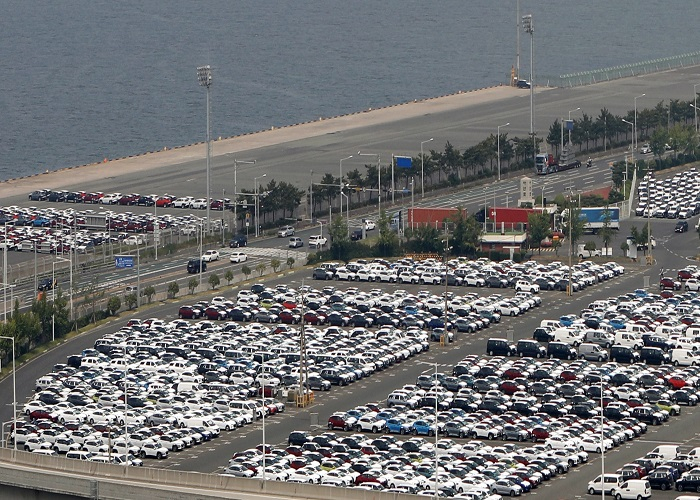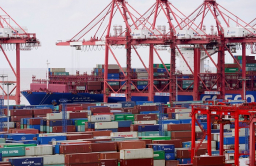-
KOSPI 2812.05 +41.21 +1.49%
-
KOSDAQ 756.23 +6.02 +0.80%
-
KOSPI200 376.54 +6.64 +1.80%
-
USD/KRW 1373 3.00 -0.22%
Korean economy nears pre-pandemic level, prompts GDP upgrades
GDP growth
Korean economy nears pre-pandemic level, prompts GDP upgrades
By
Apr 27, 2021 (Gmt+09:00)
2
Min read
News+

South Korea’s faster-than-expected economic growth in the first quarter is prompting analysts to raise their growth outlook for this year, with some even forecasting a monetary tightening move by the central bank before year-end.
Korea’s gross domestic product (GDP) grew a seasonally adjusted 1.6% in the January-March quarter from three months earlier, the Bank of Korea said on Apr. 27. From the year-earlier period, the economy expanded 1.8% in the first quarter.
The growth rate beat market expectations on both on-quarter and on-year terms.
Growth was driven by exports and facility investment, which rose 1.9% and 6.6% quarter-on-quarter, respectively. Private consumption grew a slower 1.1% on-quarter.
Korea’s economy, Asia’s fourth-largest, has been gaining momentum with a quick rebound in exports of chips, automobiles and ships.
Underpinning the momentum, Hyundai Motor Co. said last week its first-quarter net profit nearly tripled to the highest level in four years on growing demand for its pricey sport utility vehicles and premium Genesis models.
GROWTH OUTLOOK UPGRADES
With the Korean economy showing signs of recovering to pre-pandemic levels, economists at government and private research organizations are raising their projections for Korea’s full-year growth.
The International Monetary Fund (IMF) recently raised its growth outlook for South Korea this year to 3.6% from 3.1% earlier. Last month, the Organization for Economic Co-operation and Development (OECD) revised up its 2021 Korea growth outlook to 3.3% from 2.8%.
Korea’s finance ministry has said it expects the domestic economy to grow slightly faster than its earlier projection of 3.2%, as major economies, including the US, stage rapid turnarounds and boost demand for Korean exports.
Bank of Korea Gov. Lee Ju-yeol said earlier this month that “mid-3%” growth is “very likely” this year, up from the central bank’s previous forecast for 3% growth.
The BOK is widely expected to raise its 2021 economic growth outlook to 3.5-3.6% when it announces a new GDP forecast in May.

BOK RATE HIKE IN THE OFFING
One of the most bullish growth forecasts came from JPMorgan Chase Bank, which on Tuesday raised its 2021 Korea GDP outlook to a 4.6% expansion from 4.1% earlier.
“GDP growth is likely to have been more front-loaded than we expected,” said Park Seok-gil, an economist at JPMorgan, in a research note.
“The upside surprise in first-quarter performance may be followed by more modest growth in the second quarter. Yet annual GDP should rise stronger by 4.6%.”
In terms of a monetary policy implication, he said the BOK will likely send a signal to the market that the central bank will soon move to raise its benchmark rate.
“Unless the COVID-19 situation and vaccine deployment surprise us on the downside, the BOK is expected to send a hawkish signal in the fourth quarter, to be followed by actual policy rate normalization from the first quarter of 2022,” he said.
Huh Tae-oh, an analyst at Samsung Futures, said the BOK may move earlier and raise its policy rate sometime in the fourth quarter of this year in line with similar moves by central banks in other countries.
Write to Ik-Hwan Kim at lovepen@hankyung.com
In-Soo Nam edited this article.
More To Read
-
 Shipping industryFreight crunch pushes S.Korean export firms into crisis
Shipping industryFreight crunch pushes S.Korean export firms into crisisApr 25, 2021 (Gmt+09:00)
-
 Logistics challengesHMM, SM Line to deploy container ships to support Korean exporters
Logistics challengesHMM, SM Line to deploy container ships to support Korean exportersJan 22, 2021 (Gmt+09:00)
-
 Semiconductor exportsKorea’s chip exports to top $100 bn in 2021, second-best performance ever
Semiconductor exportsKorea’s chip exports to top $100 bn in 2021, second-best performance everJan 05, 2021 (Gmt+09:00)
-
Oct 27, 2020 (Gmt+09:00)
-
Sep 01, 2020 (Gmt+09:00)




